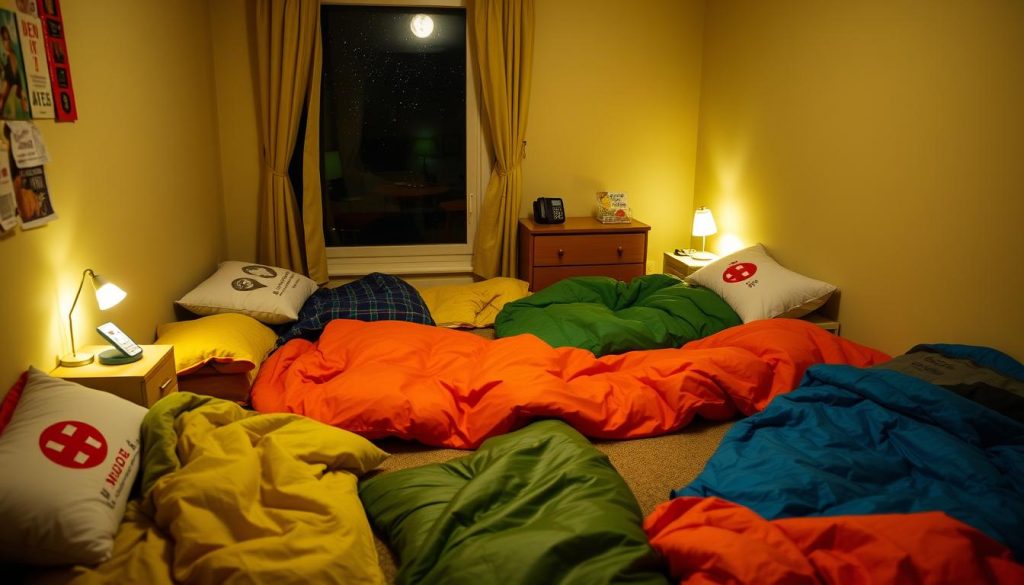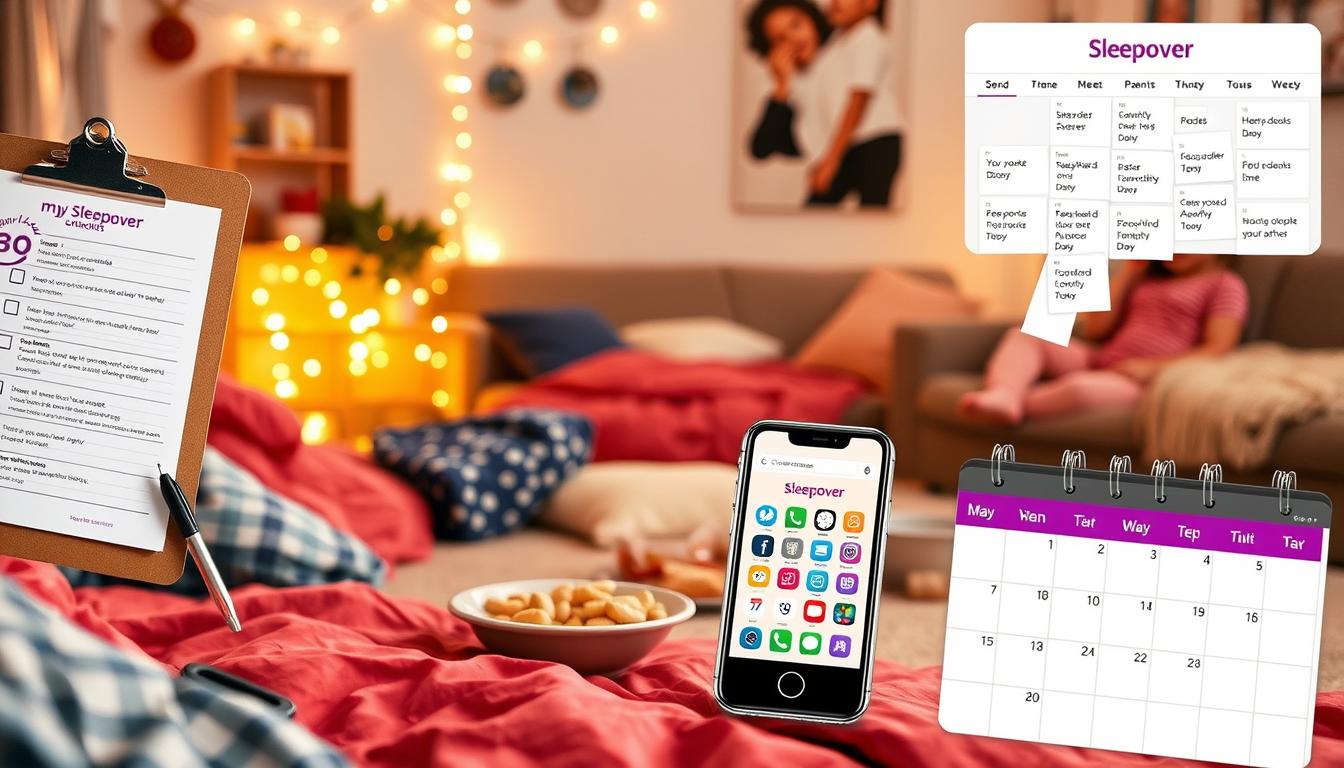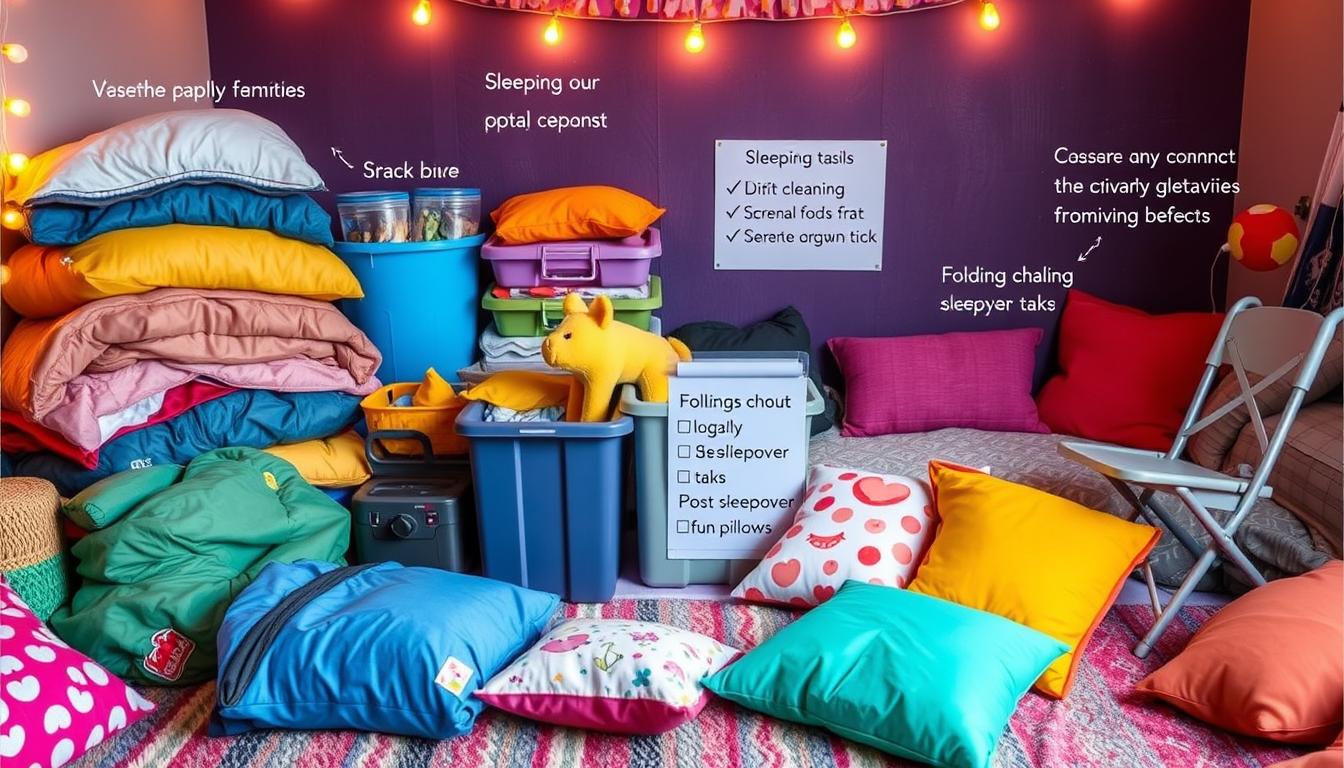Ever wondered why sleepovers can make kids and parents nervous? About 30% of parents worry about their child’s safety at these events. It’s important to have clear communication to make sure everyone has a good time.
Knowing the rules, talking openly with your child, and discussing safety are key. These steps help reduce worries and boost confidence for kids at sleepovers.
More than half of incidents happen because of poor supervision. It’s vital to talk openly with your child and the host family. Trust and safety talks can turn scary sleepovers into fun times for kids.
So, how do you have these important talks? It’s all about empowering your child and keeping them safe at sleepovers.
Understanding the Importance of Sleepover Communication
Good sleepover communication is key for safety, comfort, and fun for your child. Talking openly with other parents about sleepover expectations and home rules helps everyone feel secure. Trust grows when you discuss safety, like who watches the kids and the home environment. Always ask about any worries you might have.
Building Trust with Other Parents
Talking with parents at sleepovers can make trust stronger. Share values on keeping kids safe and who watches them. It’s important to agree on home rules and guidelines. Key points to talk about include:
- How the household is run and who supervises.
- What risks might be there and how to stay safe.
- How to set up sleeping areas, even if there are both boys and girls.
Fostering Open Dialogue with Your Child
Talking openly with your child about their feelings is important. It helps them deal with the challenges of sleepovers. Talk about:
- How they feel about the sleepover and any worries.
- Setting personal limits and saying “no” when needed.
- Handling homesickness or feeling pressured by others.
Letting your child share their thoughts boosts their confidence. It helps them handle social situations better. This builds trust and prepares them for sleepover challenges.
Sleepover Parent Communication Guidelines
Good communication between parents is key for a fun and safe sleepover for kids. By following some child sleepover guidelines, you can make sure the sleepover is a hit. Start by setting clear rules with your child and the host family. This way, everyone knows what to expect.
It’s also a chance to talk about routines and what your child likes. This helps everyone feel more comfortable and prepared.
Establishing Clear Expectations
Setting boundaries is important for safety and comfort at a sleepover. Talk to your child and the host parents about a few things:
- Bedtime routines
- Rules for screen time
- Clothing for the evening
- Food allergies or special diets
- Who to call in an emergency
Having a sleepover checklist can help remember these important details. Knowing what to expect can make everyone feel less stressed. Research shows that 30% of kids might feel forced to go to sleepovers. Clear communication helps them feel okay saying no if they need to.
Setting Up Pre-Sleepover Conversations
Talking about the sleepover beforehand can make it better. Reach out to other parents early. Share your worries and what you expect. It’s good to talk about:
- Your child’s comfort levels.
- The fun activities planned.
- If there will be alcohol.
- Any rules that are different from your home.
Keeping in touch can avoid any confusion. For example, 75% of parents talk about safety and boundaries before the sleepover. This helps everyone feel ready for the night.

| Guideline | Description |
|---|---|
| Discuss sleepover rules | Make sure everyone knows about screen time, media, and bedtime rules. |
| Communicate allergies | Find out about food allergies and have safe food options. |
| Establish contact plan | Have a plan for how to reach parents and communicate during the sleepover. |
| Debrief post-sleepover | Have a conversation with your child after the sleepover to discuss any issues. |
Being proactive can make sleepovers better and safer for your child. Good communication is the key to a positive experience. It can also help your child feel more confident about going to sleepovers in the future.
Assessing Safety Measures for Sleepovers
It’s important to check safety at sleepovers for your child’s well-being. Start by talking to the host family about supervision. Ask them how they keep an eye on the kids. Knowing who’s there, like adults, is key to a safe sleepover.
Discussing Supervision Strategies
Ask specific questions to understand safety measures. Find out if both parents will be there or if other adults will join. Feeling sure about supervision is vital.
Remember, up to 30% of sleepovers might have kids without adult supervision. Knowing the adult-to-child ratio is also important. Aim for one adult for every eight kids to keep everyone safe.
Understanding Household Environment and Activities
Talk openly about the host’s home. Knowing the layout helps spot dangers like guns or medicine not locked away.
About 15% of parents worry about guns at the host’s place. Make sure to discuss how medicine is stored. Also, talk about screen time rules, as 65% of parents are concerned about too much tech use.

Strategies for Handling Difficult Situations
Sleepovers can be fun but sometimes come with surprises. It’s key to get your child ready for these moments. An exit plan for sleepovers is a safety net for younger kids or first-timers. Let your child know they can call you anytime if they’re not feeling right or miss home.
This approach builds a supportive space through good parent-child talk.
Creating an Exit Plan
An exit plan for sleepovers can reduce worries for you and your child. Talk about these points when planning:
- Teach your child a secret code word for when they’re not okay.
- Set a time to check in with them, so they feel connected to home.
- Tell them it’s okay to call you if something doesn’t feel right, stressing their safety first.
Encouraging Your Child to Speak Up
Talking openly about sleepovers can really help your child. Encourage them to share their feelings and worries. Here’s how:
- Talk about signs that show they’re not comfortable, like avoiding eye contact.
- Let them know it’s brave to speak up about feeling uneasy, not weak.
- Teach them about staying safe, saying it’s okay to leave if they feel unsafe.
| Safety Strategy | Description |
|---|---|
| Check In | Regularly connect with your child during the sleepover to reinforce communication. |
| Code Word | Create a secret phrase for your child to use if they need help without drawing attention. |
| Parental Awareness | Meet the supervising adults to establish a trusting relationship and verify safety measures. |
| Empowerment | Train your child to recognize when something feels unsafe and to voice their discomfort. |
These tips can really boost your child’s confidence and awareness. They’ll be better at handling social situations.
Conclusion
Good communication is key for sleepovers. Following sleepover parent communication guidelines makes the experience better for kids and parents. By setting clear sleepover expectations and talking openly, you help kids feel more confident and independent. Additionally, discussing boundaries regarding shared spaces and personal belongings can foster a respectful environment for everyone involved. It’s also helpful to share sleepover privacy tips for parents to ensure that children understand the importance of personal space, even in a fun, communal setting. These guidelines not only enhance the enjoyment of the sleepover but also empower children to navigate social situations with confidence.
Preparation is important. It includes talking about allergies, safety, and making sure kids are okay with their friends. This way, sleepovers can be fun and safe for everyone.
It’s important to be careful and thoughtful when planning sleepovers. Letting kids bring favorite items and doing fun activities helps them feel at ease. Also, talking with other parents about supervision and rules is vital for safety.
Your hard work in preparing for a sleepover does more than keep your child safe. It also helps them grow socially. Regular checks, healthy snacks, and fun activities make sleepovers memorable. Your child will make friends and have great memories, feeling safe and supported.
Source Links
- How parents can safely navigate their kid’s first sleepover
- 7 Tips for a Safer Sleepover – Child Rescue Coalition
- Sleepover Guidelines That All Parents Should Know
- Should I Let My Kid Go to Sleepovers? | ParentData by Emily Oster
- A Parent’s Guide to Safe and Enjoyable Sleepovers
- Perspective: The great sleepover debate
- SLEEPOVERS – A CHECKLIST. – Sue Atkins The Parenting Coach
- Parents, Here’s How to Plan & Prepare for a Sleepover with Kids – Amerisleep
- Tips for Families: A Guide to Safe Sleepovers
- Tips for Parents: A Guide to Safe Sleepovers
- The 5 Things You Need To Know For Safe Sleepovers
- Safe Sleepovers
- Sleepovers: Our rule + Exception Clause
- Should my child go on a sleepover?
- The Parent’s Guide to Host a Elementary Kids Sleepover
- Child Safety During Sleepovers and Playdates: Guidelines for Parents
- Children and Sleepovers: What Parents Need to Know




